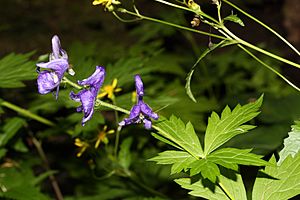Columbian monkshood facts for kids
Quick facts for kids Columbian monkshood |
|
|---|---|
 |
|
| Aconitum columbianum in Mount Baker-Snoqualmie National Forest | |
| Scientific classification | |
| Genus: |
Aconitum
|
| Species: |
columbianum
|
 |
|
| Synonyms | |
|
Aconitum geranioides |
|
Aconitum columbianum is a beautiful flowering plant. It is also known as Columbian monkshood or western monkshood. This plant is part of the buttercup family. You can find it growing in western North America. It likes wet places, such as meadows and forests. It grows at elevations from about 600 to 2,900 meters (2,000 to 9,500 feet).
Contents
What is Columbian Monkshood?
Aconitum columbianum is a tall plant that comes back every year. It grows from underground stems called rhizomes. Its stems can be long and thin. The leaves are often lobed or have jagged edges.
The flowers of this plant are quite special. They are usually a deep blue or purple color. Sometimes, they can also be white or yellowish. Each flower often has a small spur, which is a pointy part. After the flowers, the plant produces pod-like fruits called follicles.
Important Safety Information
It is very important to know that Aconitum columbianum is a poisonous plant. Like other monkshood species, it can be harmful to humans and animals. You should never touch or eat any part of this plant. Even though some types of monkshood have been used to make medicines in the past, it is very dangerous to handle them without expert knowledge. Always admire this plant from a safe distance.
Different Types of Columbian Monkshood
Within the Aconitum columbianum species, there are slightly different types. These are called subspecies or varieties. They might have small differences in how they look or where they grow. Here are some of them:
- Aconitum columbianum ssp. columbianum
- Aconitum columbianum var. howellii — also known as Howell's monkshood
- Aconitum columbianum ssp. viviparum
Images for kids
See also
 In Spanish: Aconitum columbianum para niños
In Spanish: Aconitum columbianum para niños


